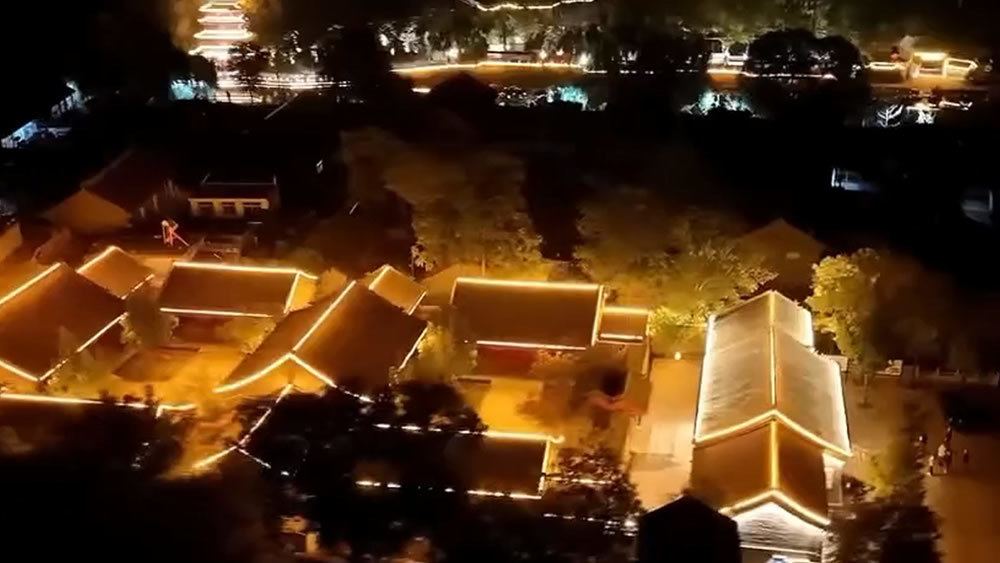




Guanyin Pavilion
Category: Introduction
Product Details
Situated on the 320-meter-high Tuolong Ridge of Baiyang Valley, the Guanyin Tower was built during the time of the North March by the Emperor Yan in Early Ming Dynasty. Legend has it that the guarding soldiers decided to build a Guanyin Pavilion on the mountain opposite to the Baiyang River in order to seek safety. All the bricks and woods were transported to the site and ready for work. In the next morning, workers found all the materials had been transported to Tuolong Ridge. Therefore, solders knelt down and worshiped to the deities, and the Guanyin Pavilion was built here.
Guanyin Pavilion is the most prosperous place in Baiyang Valley. Inside the hall are enshrined the Nanhai Guanyin Bodhisattva, the Ruyi Guanyin, the Songzi Guanyin, the Red Line Bodhisattva, and the Manjusri Bodhisattva. Those seeking for academic advancement, children, safety, and marriage will visit there and worship the deities. The main hall of the Guanyin Pavilion was restored on May 18, 2004 and burnt down on May 18, 2020. Its mysterious existence lasts for 16 years.
The Great Wall section in Baiyang Valley, which is known for its magnificent mountains and sheer passes with a length of about 4452 meters, starts at the Da Ao Tower at the conjunction with Dazhuang in the east, and ends at the Laojun Terrace in Sidaogou in the west. The Baiyang Valley section of the Great Wall still remains the original look of Ming Dynasty with zero human touch. There are totally twenty one gate towers on the wall, including six intact ones. They are Da Ao Tower, Kengzi Tower, Head Tower, Tip Tower, Square Tower, and Deity Tower from east to west. The Deity Tower stands out preeminently among all the other towers for its unique architectural style. There are many Great Wall sections in China, but Baiyang Valley section still amazes tourists. This marble section of Great Wall is 1.5KM long and was built by Qi Jiguang. It is still kept in good shape. The foundation is completely built with red marble stones with every stone weighing around 500KG. The Great Wall extends along the ridge marvelously. Therefore it is crowned as a wonder of the Great Wall built in Ming Dynasty.
The Deity Tower was built in 1596 in Ming Dynasty. It is not only a particular watch tower, but a well-designed ancient architecture. Instead of being built on the city wall, it is hung on the outer side of the wall, making it the only one of its kind along the Great Wall. The Deity Tower is more than 33 meters tall, designed in masonry structure with a flush gable roof. Since it’s built on scarcements, the direction of the whole building aligns with the Great Wall. An arch-shaped door is gouged facing the city wall, which is 2.1 meters long, 1.7 meters wide. The door has frames around it and bolts on both sides. A stone plaque, which is 1.04 meters long and 0.35 meters high, is embedded atop the door, with the characters “Shen Wei Lou” (Chinese characters of Deity Tower) inscribed on it. At the upper left corner it writes “by Zhang Shizhong, General of Guerrillas”, and at the lower right corner it writes “at the propitious moment in the summer of 1596, Wanli Reign”.
Situated on the 320-meter-high Tuolong Ridge of Baiyang Valley, the Guanyin Tower was built during the time of the North March by the Emperor Yan in Early Ming Dynasty. Legend has it that the guarding soldiers decided to build a Guanyin Pavilion on the mountain opposite to the Baiyang River in order to seek safety. All the bricks and woods were transported to the site and ready for work. In the next morning, workers found all the materials had been transported to Tuolong Ridge. Therefore, solders knelt down and worshiped to the deities, and the Guanyin Pavilion was built here.
The legend says Baiyang Valley used to be a treasure mountain owned by one goat and two sheep which were gentle and kind-hearted. A nine-eared macaque living in the mountain was their best friend, helping them guard the treasure in the mountain. But a warlock tried to seize the treasure, so the macaque drove him away. Later, the warlock killed the macaque and the goat with hidden weapons. The two sheep sorrowed for their death, hiding in the Hongyang Cave and crying every day. Their tears continuously poured out from rock cracks, hence the name “Sheep Spring”. Since the spring water flows out from rock cracks, it contains a rich content of trace elements, and tastes sweet and delicious as the top-ranking natural mineral water. Visitors to Baiyang Valley must take a sip of the water of Sheep Spring.
Consultation



